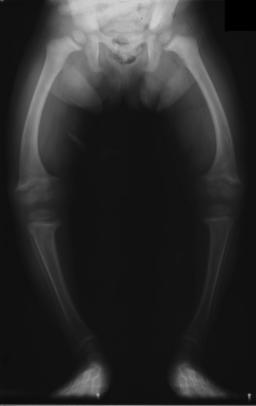Genu varum
| Genu varum | |
 | |
|---|---|
| X-Ray of the legs in a 2 year old child with rickets | |
| ICD-10 | Q68.3-Q68.5, Q74.1 |
| ICD-9 | 755.64 congenital; 736.42 acquired |
| DiseasesDB | 29404 |
| MedlinePlus | 001585 |
Editor-In-Chief: C. Michael Gibson, M.S., M.D. [1]
|
WikiDoc Resources for Genu varum |
|
Articles |
|---|
|
Most recent articles on Genu varum |
|
Media |
|
Evidence Based Medicine |
|
Clinical Trials |
|
Ongoing Trials on Genu varum at Clinical Trials.gov Clinical Trials on Genu varum at Google
|
|
Guidelines / Policies / Govt |
|
US National Guidelines Clearinghouse on Genu varum
|
|
Books |
|
News |
|
Commentary |
|
Definitions |
|
Patient Resources / Community |
|
Patient resources on Genu varum Discussion groups on Genu varum Patient Handouts on Genu varum Directions to Hospitals Treating Genu varum Risk calculators and risk factors for Genu varum
|
|
Healthcare Provider Resources |
|
Causes & Risk Factors for Genu varum |
|
Continuing Medical Education (CME) |
|
International |
|
|
|
Business |
|
Experimental / Informatics |
For patient information, click here
Genu varum or Blount's disease, commonly referred to as bow-leggedness, is a deformity marked by medial angulation of the leg in relation to the thigh, an outward bowing of the legs, giving the appearance of a bow. It is also known as bandy-leg, bowleg, bow-leg, and tibia vara. Usually there is an outward curvature of both femur and tibia, with at times an interior bend of the latter bone.
Childhood
At birth all children are more or less bow-legged. The child lies on its nurse's knee with the soles of the feet facing one another; the tibia and femur are curved outwards; and, if the limbs are extended, although the ankles are in contact, there is a distinct space between the knee-joints. During the first year of life a gradual change takes place. The knee-joints approach one another; the femur slopes downward and inward towards the knee joints; the tibia become straight; and the sole of the foot faces almost directly downwards.
While these changes are occurring, the bones, which at first consist principally of cartilage, are gradually becoming ossified. By the time a normal child begins to walk the lower limbs are prepared, both by their general direction and by the rigidity of the bones which form them, to support the weight of the body.
Causes
Some cases can be caused by medical problems, and this often gives rise to a one-sided bow-leggedness. Skeletal problems, infection, tumors and rickets can affect the growth of the leg, resulting in genu varum.
If the child is sickly, either with rickets or suffering from any ailment that prevents the due ossification of the bones, or is improperly fed, the bowed condition may remain persistent. Thus the chief cause of this deformity is rickets. Skeletal problems, infection, and tumors can affect the growth of the leg, sometimes giving rise to a one-sided bow-leggedness. The remaining causes are occupational, especially among jockeys, and from physical trauma, the condition being very likely to supervene after accidents involving the condyles of the femur.
Expectations
In most cases persisting after childhood, there is little or no effect on the ability to walk. Due to uneven stress and wear on the knees, however, even milder manifestations can see an accelerated onset of arthritis. Those with bowlegs and a genetic predisposition for developing arthritis will likely start having arthritic symptoms around age 30.
Treatment
When caused by rickets, the most important thing is to treat the constitutional disease, at the same time instructing the mother never to place the child on its feet. In many cases this is quite sufficient in itself to effect a cure, but matters can be hastened somewhat by applying splints. When the deformity arises in older patients, either from trauma or occupation, the only treatment is surgery.
Famous sufferers
- Roberto Luongo - Hockey player
- Jensen Ackles - American actor
- Daisuke Asakura - Producer and Composer
- Mack Brown - Head Football Coach at The University of Texas
- Robert Bruce - Christchurch Drag Queen
- Pavel Datsyuk - Hockey player
- Jeff Foxworthy - American Comedian
- Matt Hardy - Professional wrestler
- George Harrison - Singer, Songwriter, Musician, one of the Beatles
- Josh Howard - Basketball player
- Mahalia Jackson - Gospel singer.
- Bobby Orr - Hockey player
- William Petersen - American actor
- Tim Roth - English Actor
- Rivaldo - Footballer
- Charles Starkweather - Serial murderer
- Honus Wagner - Shortstop, one of first five men elected to the Baseball Hall of Fame
- Franco Columbu - bodybuilder
- Christina Aguilera - American Singer
- Katrina Warman - American Singer
- Glenn Dorsey - Football player
See also
References